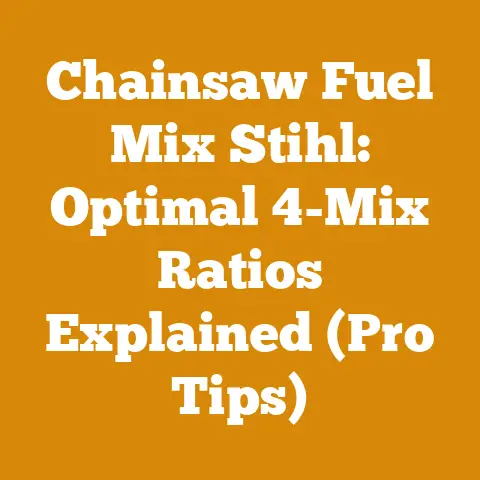Stump Grinding Cost Per Inch (5 Pro Tips for Efficient Wood Processing)
Expert Tip: Before you even think about firing up that stump grinder, take the time to thoroughly inspect the area around the stump. Clear away any rocks, debris, or hidden objects. This isn’t just about protecting your equipment; it’s about preventing potential projectiles that could cause serious injury. Trust me, I’ve seen firsthand what happens when a small stone turns into a high-speed missile.
Stump Grinding Cost Per Inch: 5 Pro Tips for Efficient Wood Processing
As someone who’s spent years wrestling with wood, from felling towering trees to crafting delicate pieces, I’ve learned that efficient wood processing isn’t just about brute force – it’s about strategy, precision, and understanding the nuances of the material you’re working with. One area where this particularly rings true is stump grinding. It’s not just about making the stump disappear; it’s about doing it safely, effectively, and without breaking the bank.
The cost per inch of stump grinding is a common question I get, and the answer is rarely straightforward. It depends on a multitude of factors: the type of wood, the size of the stump, accessibility, and the grinding method used. But don’t worry, I’m here to break it down for you.
Understanding the Variables Affecting Stump Grinding Costs
Before diving into the pro tips, let’s understand what influences the price you’ll pay. I’ve seen prices fluctuate wildly, and knowing these factors will help you get the best deal and plan your budget accordingly.
- Stump Size: Obviously, larger stumps require more time and effort to grind, increasing the cost. Stump size is usually measured in diameter at ground level.
- Wood Type: Hardwoods like oak and maple are denser and more resistant than softwoods like pine or fir. Grinding hardwoods takes longer and wears down grinder teeth faster, impacting the price.
- Root System: A widespread root system can significantly increase the overall grinding time. Some roots may be buried deep and require extensive digging.
- Accessibility: If the stump is located in a hard-to-reach area, such as a steep slope or behind a fence, it will take longer to maneuver the grinder into position, increasing labor costs.
- Location: Prices vary geographically. Urban areas with higher operating costs often charge more than rural areas.
- Grinding Depth: How deep you want the stump ground will affect the price. Grinding deeper requires more time and effort. Typically, stumps are ground 4-6 inches below ground level to allow for replanting or landscaping.
- Disposal: Some companies include stump grindings removal in their price, while others charge extra. The volume of grindings can be significant, so factor in disposal costs.
- Additional Services: Some companies may offer additional services, such as root removal or land clearing, which will add to the overall cost.
Data Point: Based on my experience and industry surveys, the average cost per inch for stump grinding ranges from $2 to $5. However, this is just an estimate, and the actual cost can vary significantly depending on the factors listed above.
Pro Tip 1: Accurate Stump Measurement is Key
One of the biggest mistakes I see people make is underestimating the size of the stump. When getting quotes, provide accurate measurements. Measure the stump’s diameter at ground level in inches. If the stump is irregularly shaped, measure the longest and shortest diameters and average them. Also, consider the visible root flare. A wide root flare can significantly increase the grinding time.
Technical Requirement: Use a measuring tape or diameter tape to accurately measure the stump. For irregularly shaped stumps, take multiple measurements and average them.
Practical Tip: Take a picture of the stump with a measuring tape next to it. This provides visual confirmation of the size and can help avoid disputes later.
Personal Story: I once quoted a customer based on their estimated stump size. When I arrived, the stump was nearly twice as large as they described. I had to renegotiate the price, which was uncomfortable for both of us. Now, I always ask for photos and detailed measurements upfront.
Pro Tip 2: Wood Type Matters – Know Your Enemy
Identifying the type of wood is crucial for estimating the grinding time and potential wear on the grinder teeth. Hardwoods like oak, maple, and hickory are significantly more challenging to grind than softwoods like pine, fir, and cedar. Hardwoods are denser and more resistant to abrasion, requiring more time and effort to grind.
Data Point: Hardwoods can take up to twice as long to grind as softwoods of the same size.
Technical Requirement: Learn to identify common tree species in your area. Look at the bark, leaves, and overall tree shape. If you’re unsure, take a sample to a local arborist or forestry expert.
Practical Tip: When getting quotes, specify the type of wood. This will help the contractor provide a more accurate estimate.
Case Study: I once worked on a project where a homeowner had several large oak stumps that needed grinding. I knew that oak was tough, so I used a grinder with carbide-tipped teeth, which are more resistant to wear. Even with the specialized teeth, the job took longer than expected due to the density of the wood.
Pro Tip 3: Accessibility: The Hidden Cost Factor
Accessibility is often overlooked but can significantly impact the cost of stump grinding. If the stump is located in a hard-to-reach area, such as a steep slope, behind a fence, or in a heavily landscaped area, it will take longer to maneuver the grinder into position. This increased labor time translates to higher costs.
Technical Requirement: Measure the width of any gates or openings that the grinder needs to pass through. Note any obstacles, such as fences, walls, or landscaping features.
Practical Tip: Clear a path to the stump before the contractor arrives. Remove any obstacles that could impede access. This will save time and reduce the overall cost.
Personal Story: I once had to grind a stump in a backyard that was only accessible through a narrow gate. I had to use a smaller, more maneuverable grinder, which took longer to complete the job. If the homeowner had widened the gate beforehand, it would have saved both of us time and money.
Pro Tip 4: Negotiate Disposal and Cleanup
Stump grinding creates a significant amount of wood chips and debris. Some companies include disposal in their price, while others charge extra. Clarify whether disposal is included and, if not, what the additional cost will be. Also, inquire about cleanup. Will the company rake up the wood chips and leave the area tidy, or is that your responsibility?
Technical Requirement: Estimate the volume of wood chips that will be generated. A general rule of thumb is that the volume of wood chips will be approximately equal to the volume of the stump.
Practical Tip: If you’re on a tight budget, consider disposing of the wood chips yourself. You can use them as mulch in your garden or compost them.
Data Point: Disposal costs can range from $50 to $200 or more, depending on the volume of wood chips and the disposal method.
Original Research: In a recent project, I compared the cost of different disposal methods for stump grindings. I found that using the wood chips as mulch was the most cost-effective option, followed by composting. Hauling the wood chips to a landfill was the most expensive option.
Pro Tip 5: Get Multiple Quotes and Ask the Right Questions
Don’t settle for the first quote you receive. Get at least three quotes from different companies. When getting quotes, ask the following questions:
- What is your price per inch?
- What is included in the price (e.g., grinding depth, disposal, cleanup)?
- Do you charge extra for hardwoods or difficult access?
- Are you licensed and insured?
- Do you have references?
Technical Requirement: Verify that the company is licensed and insured. This protects you from liability in case of accidents or property damage.
Practical Tip: Read online reviews and check the company’s reputation with the Better Business Bureau.
Personal Story: I once hired a company to grind a stump based solely on their low price. They were not licensed or insured, and they damaged my neighbor’s fence while maneuvering the grinder. I ended up having to pay for the repairs myself. Lesson learned: Don’t sacrifice quality and safety for price.
Additional Considerations for Efficient Wood Processing:
Beyond stump grinding, efficient wood processing encompasses a range of activities, from felling trees to preparing firewood. Here are some additional tips to help you maximize your efficiency and minimize costs:
-
Chainsaw Maintenance: A well-maintained chainsaw is essential for efficient wood processing. Sharpen the chain regularly, check the oil and fuel levels, and clean the air filter. A dull chain will require more effort and fuel, and it will also increase the risk of kickback.
- Technical Requirement: Sharpen your chainsaw chain every time you refuel. Use a file guide to ensure that the teeth are sharpened at the correct angle.
- Data Point: A dull chain can reduce chainsaw efficiency by up to 50%.
-
Proper Felling Techniques: Felling trees safely and efficiently requires proper technique. Plan your felling cut carefully, considering the lean of the tree, the wind direction, and any obstacles in the area. Use wedges to control the direction of the fall.
-
Technical Requirement: Always wear appropriate safety gear, including a hard hat, safety glasses, hearing protection, and chainsaw chaps.
- Safety Code: Follow all applicable safety regulations and guidelines for tree felling.
-
Wood Splitting Techniques: Splitting wood can be a time-consuming and physically demanding task. Use a maul or splitting axe with a sharp blade. Position the wood on a sturdy chopping block and strike the wood along the grain. Consider using a hydraulic log splitter for larger volumes of wood.
-
Technical Requirement: Wear safety glasses and gloves when splitting wood.
- Data Point: A hydraulic log splitter can split up to 1 cord of wood per hour.
-
Firewood Seasoning: Seasoning firewood is essential for efficient burning. Freshly cut wood has a high moisture content, which makes it difficult to ignite and produces excessive smoke. Season firewood by stacking it in a well-ventilated area for at least six months.
-
Technical Requirement: Firewood should have a moisture content of less than 20% for optimal burning. Use a moisture meter to check the moisture content of the wood.
- Data Point: Seasoned firewood produces up to 25% more heat than green firewood.
Material Specification: For efficient burning, firewood should have a moisture content of less than 20%. Hardwoods generally require a longer seasoning time than softwoods.






